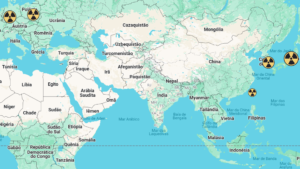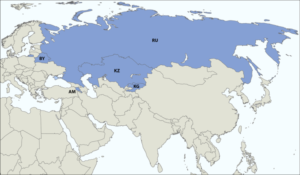- The Rail Baltic aims to connect the Baltic countries to main Europe by train, improving mobility in the region;
- This project also strengthens NATO’s energy security and defensive capabilities;
- Rail Baltic has geopolitical implications, especially with Russia and the security of the Baltic region.
Rail Baltic is a railway project for greater European integration and regional cooperation, with benefits that go beyond mobility and the improvement of local economies.
However, the project also carries possible geopolitical implications, due to its strategic location, which could create even more tensions between Russia against the European Union and NATO.

What is Rail Baltic and what are the plans for this project?
Rail Baltic is a railway project that aims to connect Poland to the three Baltic countries — Lithuania, Latvia and Estonia — with a modern and efficient railway line.
This project is one of the largest infrastructure initiatives in the region and aims to transform mobility and connectivity in the northeast of the European Union, which is currently “isolated” from the rest of the continent.
The new railway line to be built from Warsaw (Poland) to Tallinn (Estonia) will be compatible with most Western European railway networks, facilitating the transport of passengers and goods between the Baltic and Western Europe.
Plans for Rail Baltic are divided into phases. The first phase, which is scheduled to be completed by 2030, includes the construction of a high-speed rail line that will connect the capitals of the three Baltic States with Warsaw, ensuring efficiency and future expansion capacity.
Rail Baltic is part of the Trans-European Transport Network (TEN-T), a wider EU project to improve connectivity and transport infrastructure across Europe to also facilitate the transition between different modes of transport such as railways, roads and ports.
The project promises significant economic benefits, such as increasing GDP in the region, strengthening tourism and creating new businesses. Furthermore, it will improve military mobility – also benefiting NATO – and contribute to energy security by reducing dependence on fossil fuels.
From its conception in 2010 to the latest updates in 2024, the project has undergone numerous reviews and adjustments to ensure it meets the highest standards of safety, sustainability and efficiency, with an estimated total cost for the first phase of 15, 3 billion euros.

What are the benefits of Rail Baltic for NATO, the Baltic States and Ukraine?
With Finland and Sweden joining NATO, Rail Baltic’s benefits are even greater in terms of security. The railway will facilitate the movement of troops and military equipment between the Baltic countries and the rest of the NATO countries deeper into the continent, in the event of a threat on the borders with Russia, for example.
This improved mobility is crucial, especially in times of war between Russia and Ukraine. Therefore, with the railway, NATO can respond more quickly and effectively to any crisis in the region, strengthening the collective security of its members.
For the Baltic States itself, Rail Baltic is a major step forward in connectivity, being able to increase their GDPs (Gross Domestic Product) through trade and tourism, making local companies benefit from more efficient logistics for their products and services.
The project also contributes to the energy sustainability of the region. By improving transport infrastructure, it facilitates the transition to more sustainable energy sources such as electric trains, reducing dependence on fossil fuels due to the reduced need for road transport, which is more dependent on fossil fuels.
Rail Baltic is gaining even more relevance by collaborating with Ukraine on infrastructure and planning issues.
Recently, a Ukrainian delegation visited the Rail Baltic project in Riga, Latvia, to learn about the management of large infrastructure projects.
This visit is part of the effort to improve public financial management in Ukraine and prepare the country for its reconstruction.
Ukrainian representatives, including members of the government and audit bodies, sought to understand the best planning, control and financing practices seen in Latvia, essential to the success of Rail Baltic.
The new European Union regulation, which expands the trans-European transport corridors (TEN-T) to include Ukraine and Moldova (official candidates for the European Union), further reinforces the strategic importance of Rail Baltic.
How can Rail Baltic increase tensions with Russia?
Rail Baltica, in addition to being an infrastructure project with significant economic and social benefits, has a crucial geopolitical impact, especially in relation to threats from Russia.
For many Estonians, Latvians and Lithuanians, especially those who lived under Soviet rule, Russia’s war in Ukraine revives fears that the Baltic states could be the next targets.
However, research indicates that Rail Baltica arouses positive feelings among the inhabitants of the Baltic countries. Terms such as “fast”, “modern” and “future” are often associated with the project, seen as a way to better integrate these countries into the European Union.
Still, there are those who view the project with apprehension and some residents express concern, saying that perhaps Russia is focused on war with Ukraine now, but no one can predict what will happen when the railway is completed. Believing that Rail Baltic could be used as a pretext for conflict in the future.
To understand these concerns, it is essential to understand the strategic importance of the Suwalki Corridor. This corridor is a narrow strip of land that connects Poland to Lithuania, separating Russia from its heavily militarized exclave of Kaliningrad and Belarus, a close Russian ally.
Historically, the Suwalki Corridor has been seen as a vulnerable point, an “Achilles heel” of NATO. Controlling this area in times of tension could isolate the Baltic States from the rest of Europe, creating serious challenges for NATO’s defense and logistics.
The Rail Baltica project traverses the Suwalki Corridor, connecting the Baltic States directly to the rest of Europe. For NATO, this represents a significant improvement in logistics and security, strengthening the alliance’s response and defense capacity in the region. However, Russia interprets this expansion of European and military infrastructure as a strategic threat.
Therefore, it is possible that, in the long term, Russia will view Rail Baltica and NATO’s strong presence near its borders as a risk to its national security. By strengthening European integration and defense, it could increase Russia’s perception of isolation and vulnerability, especially in relation to its exclave in Kaliningrad, even if it is not the main idea of the project.
What is the geopolitical importance of Rail Baltic for the security and connectivity of the region?
Rail Baltic plays a crucial role in the security and connectivity of the Baltic region, especially in light of geopolitical tensions with Russia.
The Suwalki Corridor is an especially critical area, as if Russia militarily closes this corridor, NATO and would face serious challenges in providing basic materials, food and fuel to the three Baltic States.
Prior to Finland and Sweden joining NATO, a Russian naval blockade in the Baltic, coupled with a land blockade, would be extremely critical for the region. However, with the entry of these two countries into NATO, the Baltic Sea has become a “NATO lake“, tipping the balance of power in favor of the Western alliance.
The strategic importance of the Suwalki Corridor increased after Russia’s annexation of Crimea in 2014, highlighting the vulnerability of this passage. Russia’s invasion of Ukraine in February 2022 further reinforced this concern, making the prospect of a conflict in the region more concrete.
Kaliningrad, the Russian exclave located between Poland and Lithuania, is a key player in this scenario. With a population of nearly a million people, Kaliningrad is home to Russia’s Baltic fleet, tens of thousands of soldiers and, reportedly, nuclear weapons. The Russian military presence in Kaliningrad poses a significant threat to the security of the Baltic States and the stability of the region.
Therefore, by improving connectivity and transport infrastructure in the region, Rail Baltic strengthens the resilience of the Baltic States against possible blockades and aggression. In addition to facilitating NATO military mobility, the railway provides a crucial alternative route for transporting goods and supplies in the event of crises.




















Be First to Comment